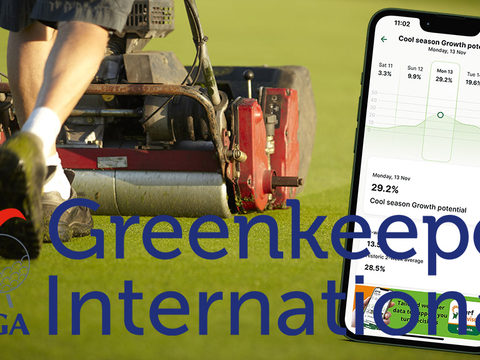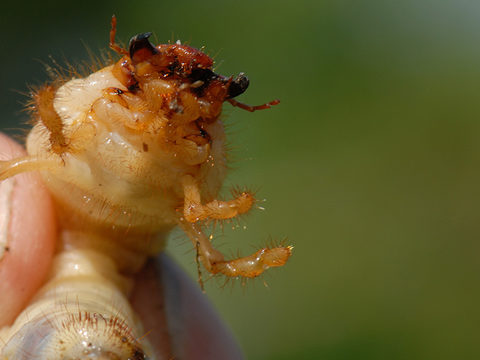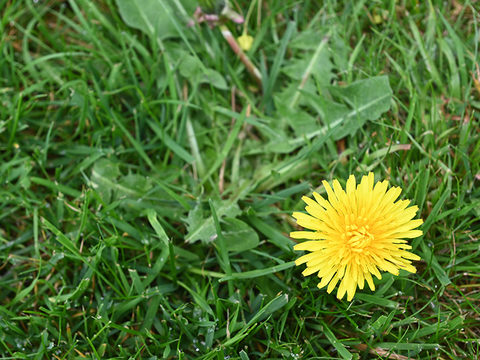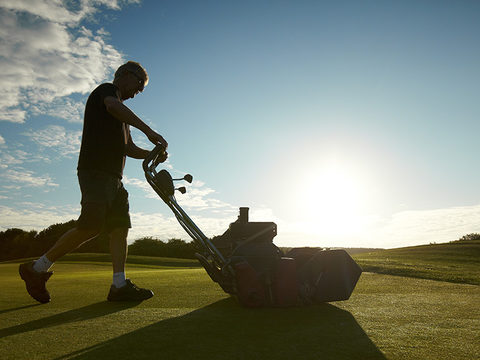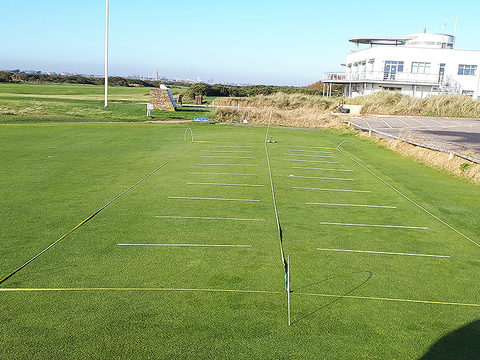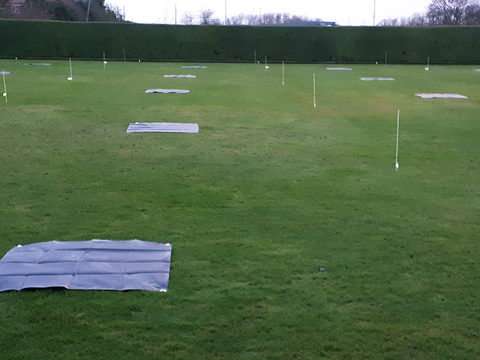GreenCast in UK and Ireland - Primo cuts the cost and carbon footprint of turf management
Cutting the carbon footprint
Golf clubs can manage turf more efficiently to reduce time, cost and overall carbon footprint by over 40% through regulating turf growth ….
A new report from Cranfield University's Centre for Sports Turf Technology has identified potential for up to 60% cut in Global Warming CO2 emissions by regulating turf growth with Primo MAXX, along with valuable financial savings in the cost of turf maintenance - amounting to an average £2000 per winter sports pitch and over £5000 across an 18-hole golf course.
The impact of climate change and the trend towards warmer conditions are well documented. Turf managers see the implications every day, in the changing seasonal effects on turf growth, pests and diseases - along with the challenge of extreme weather conditions.

The use of fossil fuels to drive energy production liberates CO2 and, coupled with mass deforestation reducing radiated heat escaping from the planet, has seen global temperatures rise by 0.74 C over the past 100 years. Recent weather patterns indicate the pace of change is accelerating.

Based on information from published sources, Syngenta technical data and interviews with turf managers and green keepers, the Cranfield University team has calculated using the CranTurfC model that Primo MAXX programmes, to regulate turf growth on sports turf and golf courses, will reduce CO2 emissions from turf maintenance by 40 to 60%, as well as reducing turf maintenance costs by between 5 and 20% (Table 1).
Reduction in CO2 emissions | Reduction in cost | |
| Winter Sports | ||
Professional | 45% | 17% |
Amateur/Recreational | 52% | 4% |
| Golf | ||
Tees | 39% | 21% |
USGA Greens | 43% | 18% |
Push-up Greens | 48% | 16% |
Fairways | 44% | 19% |
Semi-rough | 58% | 11% |
Table 1. Reduction in CO2 emissions and costs of managing turf grass with Primo MAXX applications. Source: Cranfield University Centre for Sports Surface Technology | ||
The report highlights that Primo MAXX has a wide range of beneficial effects on the maintenance of sports turf, with the key effect in reducing turf growth for extended periods of time. "This reduction in growth has associated reductions in the costs of maintenance, due to less mowing, irrigation and fertiliser being required."
Click here to see how Primo MAXX can cut the cost of turf managment.
With the reduced physical inputs used managing turf in growth regulation, there is also a major effect of reducing CO2 emissions. On tees and greens, for example, the cumulative effect of the suppressed growth rate of the grass results in the reduction of CO2 emissions; on fairways and semi-rough the mowing interval can be extended by 50 - 75%, leading to even greater savings in CO2 emissions. The Cranfield researchers factored in the physical cost and emissions from the manufacturing process in calculating the overall financial and environmental return from Primo MAXX use.
Dr James highlights that, whilst the Cranfield model did have to simplify some aspects of turf management and make some assumptions to create comparable results, there are clear practical implications. For example, the more use a mower unit receives, the more frequently the engine oil must be changed, which is directly linked to the CO2 efflux increase and with the financial costs of operation.
"We have shown for all sports turf scenarios studied, that using Primo MAXX significantly reduced the CO2 footprint, compared to the typical conventional management programmes. The range of the scale of reduction is closely linked to the reduction in mowing operations that are required to keep turf maintained for that specific amenity use," he reports. "The financial savings indicated by CranTurfC is more closely linked to the presentation of the surface, with greater savings predicted where the relative cost of maintenance is higher."
Practical implications On winter sports pitches, the Cranfield model predicts a standard sized football pitch (70 x 100m) would create a total annual CO2 efflux of 1270 kg under a standard maintenance regime. Where Primo MAXX is used, however, the efflux falls to 705 kg CO2 per year - a reduction of 45%. There is also an estimated financial saving of €30 per 100m2, equating to €2100 (£2000) a year per pitch.
Pitches managed less intensively for amateur recreational use produce less emissions - 508 kg CO2 per year with standard maintenance - but have potential for even greater percentage savings, down over 50% to 245 kg CO2 per pitch. A local authority groundsman with 10 pitches could cut the carbon footprint by over 2600 kg CO2 per year.
The report concludes that for a 'typical' 18-hole golf course with USGA greens the overall estimated CO2 footprint would be reduced from 3570 kg per year, to 1862 kg - an overall reduction of 48%. At the same time, the cost of maintenance would be reduced from an average €40,654 (£35,787) to €34,804 (£30,637) - a saving of around 14% per year.
Nitrogen effect In a further development that could see the carbon footprint of turf reduced, the CranTurfC report highlights the interaction of the effect of Primo MAXX and fertiliser on the whole soil system may also have an impact on the overall greenhouse gas release from the system. When nitrogen fertiliser is applied, up to 1% of all N applied emerges as N2O. If a USGA spec golf green is fertilised at 190 kg/ha over the season, for example, this would release approximately 1.9 kg N2O per year. Whilst only small in itself, the global warming impact of N2O is over 300 times greater than CO2, so the gas release would have a equivalence of 589 kg CO2 per ha per year.
Whilst nitrogen is still required with a Primo MAXX programme, and a small amount is recommended as a tank mix with all applications, trials and turf managers experience has indicated there may be potential to reduce overall fertiliser inputs.
Syngenta Technical Manager, Dr Simon Watson, believes this same N2O release equation applies to all nitrogenous compounds, including grass clippings. Where clippings are left on the surface, a proportion of N2O will be rapidly released; composting will also release the gas, over a longer period of time. Where Primo MAXX can reduce clipping yield by up to 80%, the release of N2O may be correspondingly reduced. "It is also important to take into account that photosynthetic activity of turf grass captures CO2 from the atmosphere," adds Dr Watson. "In practice, with Primo treated turf more energy may be retained and diverted into the development of a greater root mass, locking carbon into plant material for longer than leaf growth mown off and composted."
Environmental enhancement The CranTurfC report also identifies there may be considerable advantages with regards the overall ecological status of turf management from the application of Primo MAXX to rough and semi-rough areas of the golf course. "Research carried out as part of Syngenta Operation Pollinator is beginning to show the beneficial effects of Primo MAXX through a reduction in habitat disturbance. The capacity of the turf grass to grow and sequester atmospheric carbon is intrinsically linked to the health and functionality of the overall system," adds Dr James.
"The effect of Primo MAXX on the plant system is significant and its role in the environmentally sustainable maintenance of amenity turf has the potential to be considerable. This could demonstrate extra environmental benefits for its use." Further research is now planned to investigate the effects of Primo MAXX on other greenhouse gas efflux, including NO2 and N2O, and its use to enhance carbon capture within the sports turf system.

